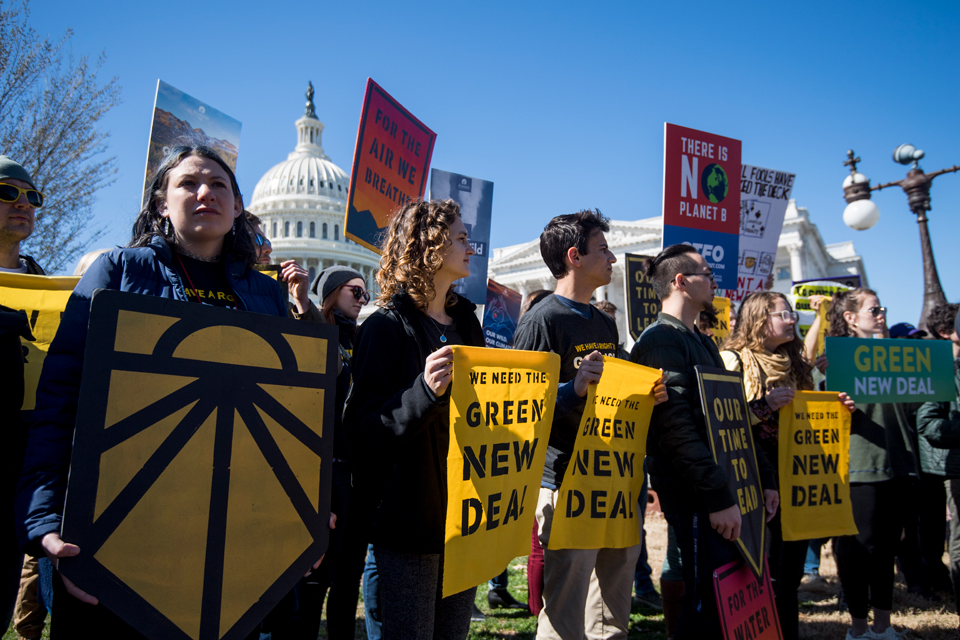
This is the second part of a 2-article series. Read Part 1 here.
In this second of two articles on the Green New Deal and the problem of profit, we will explore the remaining major policy areas targeted by the Green New Deal resolution put forward by Sen. Bernie Sanders and Rep. Alexandria Ocasio-Cortez and analyze the threats and opportunities each hold for improving the day-to-day lives of working people in the U.S. and beyond.
Creating good green jobs
An important report, Redefining Green Jobs for a Sustainable Economy, was issued this month by the Century Foundation which attempts to tackle the Green New Deal goal of creating good, high-wage, green jobs for a sustainable economy.
To know how well we’re doing in any eventual Green New Deal, we have to be able to answer a few questions. First, we need to understand what a green job is. Second, we need to be able to measure and analyze those jobs to ensure they are really living up to the meaning of the Green New Deal. According to the authors of this report, “In order to track progress on the path toward a sustainable economy, one crucial federal action is to measure green jobs. It’s hard to measure them without standardized survey data because the range of activities one does in a job can include both sustainable/low-carbon and unsustainable/high-carbon inputs and outputs.”
The danger here could come from the implied heavy reliance on the federal government to “play an active role in mandating sustainability requirements in all policy, and in measuring progress.” The national Green New Deal coalition, unions, and community-based organizations will need to watch these requirements and how they are implemented every step of the way.
Infrastructure and industry
The next Green New Deal goal is to invest in U.S. infrastructure and industry to sustainably meet the challenges of the 21st century. This goal is necessarily very broad, and it also poses the greatest threat in terms of being co-opted by the profit system, capital’s owners, and their agents in Congress.
The American Society of Civil Engineers’ Report Card for America’s Infrastructure depicts the condition and performance of American infrastructure, and it isn’t good. With an overall score of D, everything from roads and bridges to drinking water and railways is in dire need of updating. The ASCE’s estimated price tag for needed repairs was $4.59 trillion in 2017.
In order to rise to this daunting challenge, ASCE estimates that the U.S. will have to increase its investment in infrastructure from 2.5 percent to 3.5 percent of U.S. Gross Domestic Product (GDP) by 2025.
Among the steps ASCE recommends are: (1.) keeping dedicated public funding sources consistently and sufficiently funded from user-generated fees, with infrastructure trust funds never used to pay for or offset other parts of a budget; (2.) fixing the Highway Trust Fund by raising the federal motor fuel tax; (3.) authorizing programs to improve specific categories of deficient infrastructure and support that commitment by fully funding them in an expedient, prioritized manner; (4.) infrastructure owners and operators must charge, and Americans must be willing to pay, rates and fees that reflect the true cost of using, maintaining, and improving all infrastructure, including our water, waste, transportation, and energy services.
The dangers here are many, but they are far outweighed by opportunities to correct wealth distribution. For example, the ASCE claims that “Americans must be willing to pay,” and the Green New Deal coalition needs to put political pressure on Congress to enforce national fees and taxes on corporations and wealthy individuals who are not paying their fair share—or in some cases—any taxes at all. The financial burden can’t fall on individual consumers alone.
A sustainable environment
To secure clean air and water, climate and community resiliency, healthy food, access to nature, and a sustainable environment, it will take more than simple legislation or federal guidelines. In short, it will take a fundamental change in the structures of our governance and the systemic motives of our society.
Take as an example little Cuba, the island nation of about 11 million people, a mere 90 miles from Florida. As early as 2005, the late microbiologist and working-class tropical farmer Richard Levins wrote of his experience with Cuba’s ecological policies: “While the world environmental problems continue to worsen despite intensive research and rhetoric, how come a poor Third World country besieged by a hostile neighbor has been able to embark on an ecological pathway of development that combines sustainability, equity, and quality of life goals? How did it achieve a commitment to an integral program of protected areas, ecological and organic agriculture, public health levels behind only the Scandinavian countries, environmental education, occupational health, urban planning and economic development compatible with environmental protection, and compliance with the major world treaties on the environment?”
The short answer to Levins’ question is, socialism. In the words of Levins’ friend and collaborator at the Center for Marxist Education in Massachusetts, W.A. Halabi: “Private profit is the sole criterion for capitalist investment. Yet many essential projects to advance scientific development will not be profitable. If capitalist societies are too poor to ‘cure’ hunger, how can they possibly find solutions to the far more complex destruction of humanity’s environment? Indeed, capitalism can increase its short-term profits, or reduce losses through steps that harm scientific development, such as increasing work hours, cutting wages and employment, raising the price of necessities (food, fuel, etc.), polluting, etc. These steps multiply as capital’s contradictions deepen.”

Building the ecological civilization sketched out in the Green New Deal will require that workers here in the U.S. and around the globe profoundly understand and act on common interests in aligning social organization, science, and the environment. In the experience of Cuba, we see that the profit motive must be eliminated as a social force before whole-system science can begin to address human and ecological needs.
Promoting social justice and equity
Finally, the Green New Deal seeks to promote justice and equity by stopping current, preventing future, and repairing historic oppression of indigenous peoples, communities of color, migrant communities, de-industrialized communities, depopulated rural communities, the poor, low-income workers, women, the elderly, the unhoused, people with disabilities, and youth.
U.S. history is just now beginning to be unveiled for what it truly is, the systematic extermination of the native peoples, the enslavement of Africans, and the exploitation of the majority of its workers—all in the name of profit. Now that we have moved into an era of monopoly capitalism (imperialism), poverty, ignorance, and insecurity worsen with advances in science and productivity. From this contradiction, working-class people in the U.S. and abroad suffer increasing conflicts, racism, and environmental destruction.
While working-class men and women die in the U.S. military protecting the profits of the ruling elite, our public resources are causing enormous damage to health and the environment. According to a report titled The Costs of War carried out by the Watson Institute of International and Public Affairs at Brown University, the U.S. military is a bigger polluter than more than 100 countries combined.
Working people cannot avoid participating in and leading the political struggle for the Green New Deal because the survival of our species depends on quick and unprecedented action. To ensure these important objectives are not co-opted or defeated, labor, community, environmental, and social justice activists need to keep a close eye on where and when the profit motive seeks to divide and conquer.










